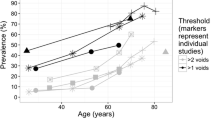Abstract
This article reviews the state of knowledge and the algorithms for the diagnosis, classification, and treatment of nocturia. The state of the art in diagnosis, classification, and treatment of nocturia is presented. Nocturia has been poorly classified and poorly understood. Multiple factors may result in nocturia, among which are pathologic conditions such as cardiovascular disease, diabetes mellitus, lower urinary tract obstruction, anxiety or primary sleep disorders, and behavioral and environmental factors. Nocturia may be attributed to nocturnal polyuria (nocturnal urine overproduction), diminished nocturnal bladder capacity, or a combination of the two. Distinction between these conditions is made by a simple arithmetic analysis of the 24-hour voiding diary. Nocturia has been poorly studied and, only recently, has been classified according to its etiology and pathogenesis. Based on a review of the current state of knowledge, this article presents a scheme for the classification and treatment of patients suffering from loss of sleep resulting from nocturnal micturition.
Similar content being viewed by others
References and Recommended Reading
Van Kerrebroeck P, Weiss J: Standardization and terminology of Nocturia. BJU Int 1999, 84(suppl 1):1–4. This paper set forth proposed standards for terminology designed to classify and quantify various etiologies of nocturia.
Umlauf MG, Goode S, Burgio KL: Psychosocial issues in geriatric urology: problems, treatment, and treatment seeking. Urol Clin North Am 1996, 23:127–136.
Abrams P, Blaivas JG, Stanton S, et al.: The standardization of terminology of lower urinary tract function. International Continence Society Committee on Standardization of Terminology. Scand J Urol Nephrol Suppl 1988, 114:5–19.
Blaivas JG, Stember DS, Weiss JP: Etiology of voiding symptoms in men: correlation of individual AUA symptom scores with urodynamic and diary parameters. Neurourol Urodyn 1998, 17:398–399.
Asplund R: The nocturnal polyuria syndrome (NPS). Gen Pharmacol 1995, 26:1203–1209. Seminal description of nocturnal urine overproduction as a major cause for nocturia.
Matthiesen TB, Rittig S, Norgaard JP, et al.: Nocturnal polyuria and natriuresis in male patients with nocturia and lower urinary tract symptoms. J Urol 1996, 156:1292–1299.
Rembratt A, Weiss J, Robertson G: Pathogenesis of nocturia in the elderly: relationship of functional bladder capacity to nocturnal urine output. J Urol 2001, 165(suppl):250.
Ozawa T, Oyanagi K, Tanaka H, et al.: Suprachiasmatic nucleus in a patient with multiple system atrophy with abnormal circadian rhythm of arginine-vasopressin secretion into plasma. J Neurol Sci 1998, 154:116–121.
KirklandJ L, Lye M, Levy DW, Banerjee AK: Patterns of urine flow and electrolyte excretion in healthy elderly people. Br Med J 1983, 287:1665–1667.
Baylis PH: Osmoregulation and control of vasopressin secretion in healthy humans. Am J Physiol 1987, 235:R671-R678.
Asplund R, Aberg H: Diurnal variation in the levels of antidiuretic hormone in elderly subjects with nocturia. J Intern Med 1991, 229:131–134.
Yalkut D, Lee LY, Grider J, et al.: Mechanism of atrial natriuretic peptide release with increased inspiratory resistance. J Lab Clin Med 1996, 128:322–328.
Partinen M: Epidemiology of obstructive sleep apnea syndrome. Curr Opin Pulm Med 1995, 1:482–487.
Krieger J, Petian C, Sforza E, et al.: Nocturnal pollakiuria is a symptom of obstructive sleep apnea. Urol Int 1993, 50:93–97.
Robinson AG: DDAVP in the treatment of diabetes insipidus. N Engl J Med 1976, 294:507–511.
Pedersen PA, Johansen PB: Prophylactic treatment of adult nocturia with bumetanide. Br J Urol 1988, 62:145.
Reynard JM, Cannon A, Yang Q, Abrams P: A novel therapy for nocturnal polyuria: a double-blind, randomized trial of furosemide against placebo. Br J Urol 1998, 81:215–218.
Hunsballe J, Rittig S, Pederson E, et al.: Single-dose imipramine reduces nocturnal urine output in patients with nocturnal enuresis and nocturnal polyuria. J Urol 1997, 158:830–836.
Adam P: Evaluation and management of diabetes insipidus. Am Fam Physician 1997, 55:2146–2153.
WeissJP, Blaivas JG: Nocturia. J Urol 2000, 163:5–12. The most comprehensive single summary of etiology, diagnosis, and treatment of nocturia.
Weiss JP, Blaivas JG: Urological Symptoms of Nonurologic Origin. American Urological Association Update Series: Lesson 17; 2002.
Van Kerrebroeck P, Abrams P, Chaikin D, et al.: The standardization of terminology in nocturia: report from the Standardization Sub-Committee of the International Continence Society. Neurourol Urodyn 2002, 21:179–183.
WeissJP, Stember DS, Blaivas JG: Nocturia in adults: classification and etiology. Neurourol Urodyn 1997, 16:401. Original work documenting the use of newer nocturia indices demonstrating multifactorial etiologies of nocturia with an emphasis on the issue of nocturnal urine overproduction.
Author information
Authors and Affiliations
Rights and permissions
About this article
Cite this article
Weiss, J.P., Blaivas, J.G. Nocturia. Curr Urol Rep 4, 362–366 (2003). https://doi.org/10.1007/s11934-003-0007-1
Issue Date:
DOI: https://doi.org/10.1007/s11934-003-0007-1




